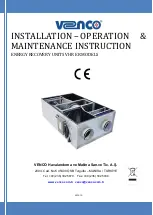
ENGLISH
21
WIRING DIAGRAM
1.
Power switch
2.
Thermal fuse
3.
Settings
4.
Settings
5.
Primary winding
6.
Secondary winding
7.
Rectifier
TROUBLESHOOTING
Fault
Cause
The weld joint is too thick.
The welding tip has been moved too slowly over
the workpiece.
The weld joint is "fibrous" or incomplete.
The welding tip has been moved too quickly over
the workpiece.
The welding arc is unstable, with excessive
spatter and porous weld joint.
The welding tip has been held too far from the
workpiece.
There is rust, grease or paint on the workpiece.
The welding electrode is burning back all the
time.
The welding tip has been held too near the
workpiece.
Intermittent interruption in the welding circuit
caused by:
- Loose contact tip, tighten.
- Damaged contact tip, replace.
- Incorrect size of contact tip for the actual welding
electrode, replace.
- Welding electrode or casing corroded, replace.
- Damaged feed rollers, replace.
- Incorrect roller pressure. Increase the pressure
until slight pressure from a finger does not stop the
feeding of the welding electrode.
- Pressure roller jams. Check that the rollers rotate
freely. Lubricate or replace as necessary.
- The welding electrode is entangled on the coil.
A hole is burned in the workpiece.
The welding tip is moved too slowly or too unevenly
over the workpiece.
The welding input is too high.
Inadequate penetration.
The welding tip has been moved too quickly over
the workpiece.
Welding input too low.
The feeding of the welding electrode is too slow.
No welding arc.
Check the connection of the earth clamp.
Check the earth lead and welding cable for "open
circuit", replace if necessary.
The welding machine does not work when you
press the trigger.
The thermal overload protection has tripped. Allow
the machine to cool.
Check the connections/couplings on the trigger.
The welding machine does not work, the mains
indicator does not light up.
Check the mains fuse.
Check the connection to the mains voltage supply.


































